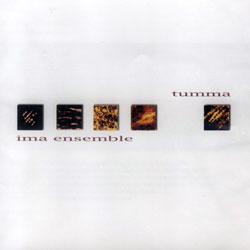
In 1982, Peter Gabriel reunited with Genesis to fund his WOMAD (World of Music, Arts and Dance) project. Successful with this endeavor, Gabriel's WOMAD (started in 1987) became an annual event that brought non-Western arts to Westerners. Though Gabriel's efforts did raise an incredible amount of resources for starving nations, the byproduct is unforgivable: the perpetuation of the term "world music", a reductive label commonly branded on every style of music outside the United States (or England, as the case may be). A bastard, this commodity generally only sells once it strangleholds the original melodies and rhythms of the foreign body with a 4/4 beat, unwavering tempi and placid keyboard pads (Dead Can Dance, a group tainted with blushing naïveté, though steeped in natural instinct and courageous ambition, is exempt from this pejorative critique).
However, there are occasional stand-outs in the swollen "Ethnic" record bins. Ima Ensemble main-man and Toronto native, Debashis Sinha, is one such example, a musician who rises above the gauche, trend-obsessed Philistines of electronics-meets-exotic-acoustic-instruments who took a weekend seminar to earn a "master drummer" certificate. Raised by a mother who studied with Uday Shankar (Ravi's older sibling), Sinha is an unrelenting student of percussion techniques, technology and Middle-Eastern and Indian music, someone who believes the intersection of West vs. East is found in homage, deep respect and improvisation, not the quantization of elements into a bourgeoisie synthetic beat fit for background sound in a hair salon.
Armed with numerous percussion instruments, guitar, sintir and Max/MSP, and accompanied by chanteuses Jayne Brown and Sophia Grigoriadis, Sinha weaves a host of influences with his own unique approach to form a tasteful new voice (Ima is, after all, the Japanese word for "now") for these ancient traditions. On "Hum", Sinha works a collage of dumbek, low-frequency drums, his own grunts and spoken melodic sighs into a ghostly multi-metered, multi-tracked flurry; "Zaidi Zaidi" features Brown and Grigoriadis in duet, offering somber folk song while Sinha carefully guides reverb and complicated drones. Often, Sinha prefers intimate passages of single instrument performances — such as "Traveller" (sic), a demonstration of his ability to vamp on and gently reshape classic Tar (a large frame drum) rhythms, and "Ng Ta", a morphing bell-driven metronome in the vein of Steve Reich's "Pulses" (from Music For 18 Musicians). For the highlight of the disc, "Lion", Sinha plays a slinking string groove by way of Cairo (then Mississippi then Led Zeppelin II), inspiring head nods and swaying even before the thump, clap and tambourine enter; Sinha's gravelly choir-of-one and breathy accents only further the spiritual cool.
Whether, built from talent, training, experience, birthright, or a genuine devotion to music, not reward — or all of these — a soul is present in each of these works, one not easily counterfeited.
Comments and Feedback:



More Recent Reviews, Articles, and Interviews @ The Squid's Ear...


|

